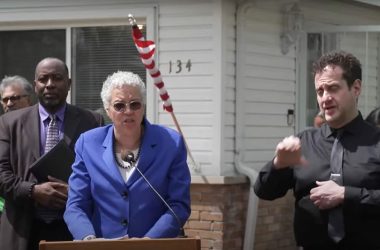Kirk, Durbin, Johnson Lead on Agenda to Improve Stroke Research, Rehabilitation, Return to Work
CHICAGO–(ENEWSPF)–July 1, 2013. U.S. Senators Mark Kirk (R-Ill.) and Dick Durbin (D-Ill.) today attended the groundbreaking of the Rehabilitation Institute of Chicago’s massive state-of-the-art medical facility that will feature cutting-edge technology meant to change the way physical medicine and rehabilitation is delivered in the United States. The facility will feature five interdisciplinary Innovation Centers to dedicated brain, spinal cord, nervous system and limb impairments in adults and children.
“I know better than most the important role that rehabilitation plays in recovering from major trauma,” Sen. Kirk said. “That’s why Senator Durbin and I introduced the Preserving Rehabilitation Centers Act to help ensure that this incredible new RIC facility, and other top notch facilities throughout the nation, are able to help as many people as possible. The more people who get access to high-quality rehabilitation, the more people we can get back to work.”
“Leading rehabilitation centers like RIC combine research and patient care to serve those with complex conditions like brain trauma, stroke and wartime injuries,” said Sen. Dick Durbin. “We need to be sure we understand what it takes to provide that treatment and whether the payment models we use today are sufficient. The Preserving Rehabilitation Centers Act will ensure that cutting-edge rehabilitation centers can continue to provide the high standard of care from which Senator Kirk, Eric Edmundson and so many others have benefited.”
Last week, Sens. Kirk and Durbin introduced S. 1220, the Preserving Rehabilitation Centers Act of 2013. The bill designates a national network of unique inpatient rehabilitation facilities, like the Rehabilitation Institute of Chicago (RIC), that are national leaders in research and innovative care for individuals with complex rehabilitation needs. RIC and other designated rehab facilities are often a last resort for people with wartime injuries from burns and amputations, spinal cord injuries, rare neurological diseases, traumatic brain injury, and stroke.
In May, National Stroke Awareness Month, Sen. Kirk, along with Sen. Tim Johnson (D-SD), introduced S.1027, the Kirk-Johnson Rehabilitation Improvement Act, which aims to improve, coordinate, and enhance rehabilitation research at the National Institutes of Health (NIH) without authorizing new spending or contributing to our nation’s large and growing deficit.
Both Senators Kirk and Johnson have experienced firsthand the extraordinary benefits that rehabilitation can yield to patients recovering from physical and neurological events. Changing the way that rehabilitation is defined and updating the structure of NIH will better address long-term needs of the population, helping others return to work and live more independently.
Senator Kirk, who suffered an ischemic stroke in January 2012, benefited greatly from a unique research trial at the Rehabilitation Institute of Chicago (RIC) as part of his rehabilitation. The trial focused on improving gait pattern through an intense regimen of continuous walking over flat surfaces, on stairs and on a treadmill every day. After nearly a year of intensive recovery and rehabilitation, Senator Kirk returned to work by climbing the 45 steps of the U.S. Capitol on January 3, 2013.
“After my stroke, I faced the prospect of never walking again,” Sen. Kirk said. “Thanks to recent advances in rehabilitation and my participation in the walking research trial at RIC, I have made an incredible recovery. Every stroke victim should have that same opportunity, which is why I have teamed up with Senator Johnson to introduce the Rehabilitation Improvement Act.”
On December 13, 2006, Senator Johnson suffered an intracerebral bleed caused by a congenital arteriovenous malformation (AVM). Following surgery and as his rehabilitation progressed, Senator Johnson remained committed to South Dakotans, working from home until he returned to his Senate office on September 5, 2007.
“After my AVM and during my recovery process, I believe I was given a second chance at life—and it would not have been possible without the excellent rehabilitative care I was given,” Sen. Johnson said. “That’s why I joined with Senator Kirk on this bill; it will help give a better opportunity of recovery to patients by conducting critically important rehabilitation research and making advances in patient care.”
The Kirk-Johnson Rehabilitation Improvement Act reduces duplication in research by establishing a working group within NIH to update and streamline rehabilitation priorities, enhances future research by training and promoting interagency cooperation between NIH and other agencies, and modernizes existing language to reflect the recent growth and need in therapy innovation. The legislation has earned support from several notable medical organizations, including the Disability and Rehabilitation Research Coalition and the American Occupational Therapy Association.
“A large coalition of disability, scientific, and provider organizations applaud Senator Kirk and Senator Johnson for introducing bipartisan legislation intended to improve rehabilitation research at NIH so that all Americans following injury, illness or disability can benefit from the same type of innovative and effective rehabilitation services and devices they were afforded,” Peter Thomas of the Disability and Rehabilitation Research Coalition said. “We look forward to working closely with Senators Kirk and Johnson to advance this legislation and implement recommendations to enable rehabilitation research to thrive at NIH.”
“Achieving optimal potential is the goal of occupational therapy and it is the goal of S.1027 to achieve the optimal potential of the National Institutes of Health and the National Center for Medical Rehabilitation Research,” Christina Metzler of the American Occupational Therapy Association (AOTA) said. “AOTA and the 140,000 occupational therapy practitioners, educators and researchers around the nation applaud Senator Mark Kirk and Senator Tim Johnson for this bipartisan legislation intended to improve, coordinate, and enhance rehabilitation research to meet the needs of Americans who face illness, disability or injury in their daily lives.”
Stroke is the leading cause of long-term disability in America and, according to recent data released by the American Heart and Stroke Association, 45-64 year olds are expected to see the highest increase in stroke in the coming years. Stroke-related medical issues and lasting physical disabilities make returning to work difficult for many stroke patients. Of the approximate 800,000 Americans who survive stroke each year, only about one-third reenter the workforce. Intense physical and occupational therapy are critical in helping people learn how to live full lives after stroke. Senator Kirk introduced the Return to Work Act of 2013, which encourages employers to use the resources of the Job Accommodation Network within the Department of Labor to help stroke survivors return to work.
Source: kirk.senate.gov








